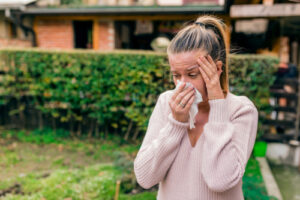Eye irritation can interrupt daily life. General symptoms like redness and watery eyes can occur if you have dry eyes or seasonal allergies.
It’s essential to understand which condition is causing your symptoms. Keep reading to learn more about how to tell the difference between dry eye syndrome and allergies.
Allergies

Plants emit dust-like pollen to grow fruit. This material flows through the air and spreads in the wind. It may land on your clothes or hair and make it into your home. There, it can be airborne, floating around in the air and all around you.
You experience allergies as your eyes have a histamine reaction to pollen. When this happens, the blood vessels in the eye swell, causing allergic conjunctivitis.
Many people with allergies find themselves rubbing or scratching their eyes to relieve itchiness. You may rub at your eyelids to relieve this feeling, which only makes them redder.
Burning and sensitivity to light are often signs of allergic conjunctivitis. Your eyes will also water to try and remove the pollen. You might frequently feel teary-eyed without any emotional connection to the reaction.
Seasonal allergies can cause puffy skin around the eyes. You could also have under-eye circles as if you have a fading black eye.
If you have allergies, you may notice discomfort and other symptoms in the spring through the fall, as these are the most common seasons for pollination.
It’s possible to develop allergies as you age. Some people have no issues one year but struggle with eye irritation the next.
Avoid allergy symptoms by using a HEPA filter in your HVAC to remove pollen from the air. Switch filters every one or two months.
Watch your local weather to learn when pollen counts are highest. Avoid going outside or doing yard work that may expose you to large amounts of plant matter. Change clothes when you come inside to avoid plant particle transfer.
Dry Eye

Inadequate lubrication is one of the causes of dry eye syndrome. Your eyes create tears and oil that spread across the cornea when you blink.
Many people describe dry eyes as feeling like there is something in their eyes. Your eyes may appear red and feel like they’re burning. Blurry vision and sensitivity to light are also common symptoms.
Some people have meibomian gland dysfunction that prevents the flow of an oily secretion. The material creates a film over the eye to stop the tears from evaporating too quickly.
Your body may not make enough of this mixture to keep the eye moist. Or, the glands could be blocked, limiting the oil and tears that coat the eye.
Age is one of the biggest reasons why people have dry eyes. It’s prevalent among people over age 50 because they produce fewer tears. Women have a higher risk of dry eye syndrome because of hormonal changes.
Conditions like rheumatoid arthritis and lupus can also cause dry eyes. People who take hormone replacement therapy or high blood pressure medications have a higher chance of developing dry eyes.
Treatment Options
Discuss any eye discomfort that you’re experiencing with your eye doctor. If you have dry eye symptoms, they will likely recommend trying over-the-counter drops to increase lubrication. Talk with your physician about changing medications that may cause dry eyes.
If your symptoms include itchiness, you likely have seasonal allergies. Treat this condition with allergy medications like antihistamines and environmental awareness.
If you’re tired of dry eye symptoms getting in your way, treatment may be the solution. Schedule an appointment at Fichte, Endl & Elmer Eyecare in Buffalo, NY, on our website or call us at 1-800-309-2020 now!


